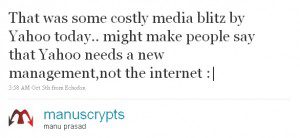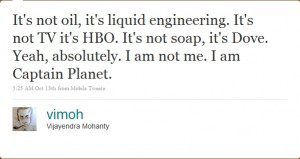Media Post reports that Yahoo’s latest campaign caused its perception among U.S. adults to fall steeply – apparently, YouGov’s BrandIndex, which tracks daily consumer perception of brands, found that Yahoo’s buzz score had tumbled from 35.4 on Sept. 22 to 25.5 as of Monday. Acknowledging India’s growing significance, the $100 million (global) “It’s Y!ou” campaign was rolled out in India too – y!ou couldn’t have missed the “disruptive” frontpage takeover of multiple mainstream dailies or the TVCs. My views on it were expressed in <140 characters

Before you take me for some kind of Yahoo hater, I’m not. (Actually, I’m quite a fan of the Carol Bartz style of no-nonsense management – typified by the last few lines here) In fact my irritation with them stems from their relative disinterest towards a few tools that were original pathbreakers and that they’ve had for a long time – most importantly ‘delicious’, but I’ve written about that earlier, and some work on that service has happened since. So, anyway, Yahoo, this is not about you, you were simply a prolongued prologue, and a good example.
A couple of weeks back, when writing about Wave, I’d wondered “is brand equity an excuse/surrogate for thin value, and exist only in theory, or until the last good product?” This entire activity above somehow reminded me of that. Brand equity, and the lord knows there’s no shortage of definitions. (ignore the newspaper brand references) So why did I think brand equity is now a surrogate/excuse for thin value?
Every brand that enjoys good equity now must have provided ‘thick value’ at some point of time, to its audience. At some point though, did the ‘brand’ take over, and the focus become more on perception management, rather than as an aid to retaining/attracting customers. Is that the reason why brands in many industries cannot find a way past the disruption they’ve been facing – because they’ve been focused on creating brand equity basis communication and superficial value additions, and sticking way too close to the specifics, like competition, and not bothering about the generic fulfilment of a need?(classic example, newspapers and news delivery) Somewhere did brand and marketing communication start dominating the proceedings, at the cost of the basics – a product solving a need/a distribution that increases convenience/the factor that built the equity in the first place? And then did they shortchange consumers by putting a premium on the brand’s equity without delivering value? While trying to build the emotional connect and create a value perception beyond the commoditisation, did the means become the end?
Take Yahoo for example. By an unfortunate coincidence, last week, GMail replaced Yahoo Mail as the most popular email service in India. I can imagine why. Like many others, I have multiple Gmail ids, and a Yahoo id too. While I open Yahoo because of a couple of e-groups, GMail is my primary communication centre. It has never been static, features and tools have been added to a point where I wonder how I worked without them. (try operating in basic HTML for a while) I checked Yahoo out again, with as fresh a perspective as i could, and didn’t find anything that could make me consider a shift. I still use Delicious a lot, and it still has a lot of equity (in my mind) going for it. Yahoo’s brand campaigns have nothing to do with it.
Maybe the concept of brand equity had some merit when the audience didn’t talk to each other, but as WOM keeps getting bigger, push brand communication is bound to become more meaningless. As consumption patterns change, needs change, distribution systems change, as real-time becomes the norm, and exit barriers and costs for consumers come down, relying on a static and uni dimensional concept of brand equity is bound to be harmful. Also, with fragmenting media, fragmenting audiences, and an increasing importance for ‘my experience’, brand equity will be different things to different people at different times, and even the hazy setof objective measurements in vogue today, would be rendered ineffective. (Yes, it might have been the same before, but in an earlier era, consumers did not talk to each other, and it was easy to push the brand’s equity on to consumers). (Generalising, but) Take a look at the communication and taglines adopted by brands, their superficiality, the efforts that go into forcing the tagline’s emotion/value into the actual value provided, and thereby build/increase brand equity and you’ll see what I mean.

Perhaps, product equity will be the only measure that matters, and brand equity will be earned and burned real time, as consumers share feedback and rely on their trusted sources for updates, and historic performances will decrease in significance. (when the Fail Whale comes out on Twitter, evangelists become bloodhounds, or whatever..you know what I mean) And so perhaps, from a brand perspective, its about time that meaningless communication took a back seat, and we went back to the basics of brand equity, that may mean redefining the roles and responsibilities of everyone associated with ‘brand’ as a function. Because if you’re good, they’ll talk about you, and if you’re bad, they’ll talk more about you 🙂
But you know what, I had more fun when i thought about a parallel. Thought leaders. Replace ‘brand equity’ with ‘thought leaders’ (or personal brand equity) and tell me what you think. 🙂
UPDATE: Yahoo hires a new agency, tells Ogilvy “It’s not Y!ou”.. Damn, that was fast!!
UPDATE 2 Meanwhile, a homepage redesign gives them 9% more page views and 20% more time spent.
until next time, equitable solutions..
Bonus Reads:
Almost unrelated, but an excellent read – Jerry Yang’s Advice in Interesting Times (via @mukund)

Nice thoughts. Infact, I personally feel Yahoo(!) is on the path to be the next megalomaniac after MSFT. No strings attached since I personally still love some of the products like you do. But I never liked big web giants going the traditional way to let us know that they exist since its never in its DNA I believe.
But away from the topic, can you please point me to the article where $100 Mn dollar is mentioned as the global campaign cost (other than AdAge).
Thanks
@Sampad
well, it might be justified if there was something that would really change the way we use the web.. to me, this doesn’t…many argue that in India, mass media is still essential even for a web-only product.. i guess it could be argued both ways..
and here you go – http://bit.ly/S3ohh and http://bit.ly/8cXkQ (TC and RWW)
Like you mentioned they need to string together all their services much like yahoo does. Check out http://everything.yahoo.com/ see what all they have.. it’s quite impressive, the problem is that there’s nothing stringing them together other than the common email id used to access them. There’s no uniformity. Yahoo’s like West Indies cricket team, a non-existant country who come together just for the purpose of playing cricket. As a stand alone product delicious is like Trinidad & Tobago (man I totally liked the way they’re laying in champions league) but under west indies they’re nothing. There is no display. Plus every yahoo product looks so different just try going to home page of every product, they’re so drastically different!
They put too much emphasis on their homepage, yahoo.com. I think it’s high time they move beyond the ‘portal’ funda. Everyone knows portals are dead, no matter how gorgeous they look, people will not use them. They need to concentrating on each of these individual products they have, instead of building a brand out of nothing. Advertise delicious, advertise yahoo upcoming, MyblogLog, omg! but not yahoo. Because Yahoo! means nothing for a customer.. yahoo.com is a not a seach engine, not an email service, not an OS, oh then what is it? A huge company that’s sitting on tons of amazing products! Portal is a concept no one can relate to any longer.
You mentioned Batz’s no-nonsense management, well this ad campaign was total nonsense. Yoddle? What? Why? What do we get out of it? If you’re spending millions on ads, why don’t you tell us what you have instead of speaking in the air.. vague stuff? Why don’t you tell us what yahoo has than google or ms doesn’t have? Or did I miss something?